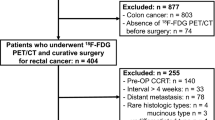Abstract
PURPOSE: The purpose of this prospective study was to determine the ability of fluorine-18 fluorodeoxyglucose positron emission tomography to assess extent of pathologically confirmed rectal cancer response to preoperative radiation and 5-fluorouracil-based chemotherapy. METHODS: Patients with primary rectal cancer deemed eligible for preoperative radiation and 5-fluorouracil-based chemotherapy because of a clinically bulky or tethered tumor or endorectal ultrasound evidence of T3 and/or N1 were prospectively enrolled. Positron emission tomography and CT scans were obtained before preoperative radiation and 5-fluorouracil-based chemotherapy (5,040 cGy to the pelvis and 2 cycles of bolus 5-fluorouracil with leucovorin) and repeated four to five weeks after completion of radiation and 5-fluorouracil-based chemotherapy. In addition to routine pathologic staging, detailed assessment of rectal cancer response to preoperative radiation and 5-fluorouracil-based chemotherapy was performed independently by two pathologists. Positron emission tomography parameters studied included conventional measures such as standardized uptake value (average and maximum), positron emission tomography-derived tumor volume (size), and two novel parameters: visual response score and change in total lesion glycolysis. RESULTS: Of 21 patients enrolled, prospective data (pretreatment and posttreatment positron emission tomography, and complete pathologic assessment) were available on 15 patients. All 15 demonstrated pathologic response to preoperative radiation and 5-fluorouracil-based chemotherapy. This was confirmed in 100 percent of the cases by positron emission tomography compared with 78 percent (7/9) by CT. In addition, one positron emission tomography parameter (visual response score) accurately estimated the extent of pathologic response in 60 percent (9/15) of cases compared with 22 percent (2/9) of cases with CT. CONCLUSIONS: This pilot study demonstrates that fluorine-18 fluorodeoxyglucose positron emission tomography imaging adds incremental information to the preoperative assessment of patients with rectal cancer. However, further studies in a larger series of patients are needed to verify these findings and to determine the value of fluorine-18 fluorodeoxyglucose positron emission tomography in a preoperative strategy aimed at identifying patients suitable for sphincter-preserving rectal cancer surgery.
Similar content being viewed by others
References
Minsky BD. Adjuvant therapy for rectal cancer: results and controversies. Oncology 1998;12:1129–39.
Grann A, Minsky BD, Cohen AM,et al. Preliminary results of preoperative 5-fluorouracil, low-dose leucovorin, and concurrent radiation therapy for clinically resectable T3 rectal cancer. Dis Colon Rectum 1997;40:515–22.
Meterissian S, Skibber J, Rich T,et al. Patterns of residual disease after preoperative chemoradiation in ultrasound T3 rectal carcinoma. Ann Surg Oncol 1994;1:111–6.
Kahn H, Alexander A, Rakinic J, Nagle D, Fry R. Preoperative staging of irradiated rectal cancers using digital rectal examination, computed tomography, endorectal ultrasound, and magnetic resonance imaging does not accurately predict T0,N0 pathology. Dis Colon Rectum 1997;40:140–4.
Cance WG, Cohen AM, Enker WE, Sigurdson ER. Predictive value of a negative computed tomographic scan in 100 patients with rectal carcinoma. Dis Colon Rectum 1991;34:748–51.
Patanaphan V, Salazar OM. Colorectal cancer: metastatic patterns and prognosis. South Med J 1993;86:38–41.
Strauss LG, Clorius JH, Schlag P,et al. Recurrence of colorectal tumors: PET evaluation. Radiology 1989;170:329–32.
Engenhart R, Kimmig BN, Strauss LG,et al. Therapy monitoring of presacral recurrences after high-dose irradiation: value of PET, CT, CEA and pain score. Strahlenther Onkol 1992;168:203–12.
Flanagan FL, Dehdashti F, Ogunbiyi OA,et al. Utility of FDG-PET for investigating unexplained plasma CEA elevation in patients with colorectal cancer. Ann Surg 1998;227:319–23.
Ogunbiyi OA, Flanagan FL, Dehdashti F,et al. Detection of recurrent and metastatic colorectal cancer: comparison of positron emission tomography and computed tomography. Ann Surg Oncol 1997;4:613–20.
Haberkorn U, Strauss LG, Dimitrakopoulou A,et al. PET studies of fluorodeoxyglucose metabolism in patients with recurrent colorectal tumors receiving radiotherapy. J Nucl Med 1991;32:1485–90.
Ito K, Kato T, Tadokoro M,et al. Recurrent rectal cancer and scar: differentiation with PET and MR imaging. Radiology 1992;182:549–52.
Beets G, Penninckx F, Schiepers C,et al. Clinical value of whole-body positron emission tomography with [18F]fluorodeoxyglucose in recurrent colorectal cancer. Br J Surg 1994;81:1666–70.
Abdel-Nabi H, Doerr RJ, Lamonica DM,et al. Staging of primary colorectal carcinomas with fluorine-18 fluorodeoxyglucose whole-body PET: correlation with histopathologic and CT findings. Radiology 1998;206:755–60.
Rusch V, Klimstra D, Venkatraman E,et al. Aberrant p53 expression predicts clinical resistance to cisplatin-based chemotherapy in locally advanced non-small cell lung cancer. Cancer Res 1995;55:5038–42.
Larson SM, Erdi Y, Akhurst T,et al. Tumor treatment response based on visual and quantitative changes in global tumor glycolysis using PET-FDG imaging. Clin Positron Imaging 1999;2:159–71.
Willett CG, Warland G, Hagan MP,et al. Tumor proliferation in rectal cancer following preoperative irradiation. J Clin Oncol 1995;13:1417–24.
Mohiuddin M, Marks G, Bannon J. High-dose preoperative radiation and full thickness local excision: a new option for selected T3 distal rectal cancers. Int J Radiat Oncol Biol Phys 1994;30:845–9.
Bannon JP, Marks GJ, Mohiuddin M,et al. Radical and local excisional methods of sphincter-sparing surgery after high-dose radiation for cancer of the distal 3 cm of the rectum. Ann Surg Oncol 1995;2:221–7.
Lai DT, Fulham M, Stephen MS,et al. The role of whole-body positron emission tomography with [18F]fluorodeoxyglucose in identifying operable colorectal cancer metastases to the liver. Arch Surg 1996;131:703–7.
Delbeke D, Vitola JV, Sandler MP,et al. Staging recurrent metastatic colorectal carcinoma with PET. J Nucl Med 1997;38:1196–201.
Author information
Authors and Affiliations
Additional information
Supported in part by the Gerschel Foundation and the National Cancer Institute, R01 CA82534-01.
Dr. Ruo is McEachern Fellow of the Canadian Cancer Society.
About this article
Cite this article
Guillem, J.G., Puig-La Calle, J., Akhurst, T. et al. Prospective assessment of primary rectal cancer response to preoperative radiation and chemotherapy using 18-fluorodeoxyglucose positron emission tomography. Dis Colon Rectum 43, 18–24 (2000). https://doi.org/10.1007/BF02237238
Issue Date:
DOI: https://doi.org/10.1007/BF02237238




